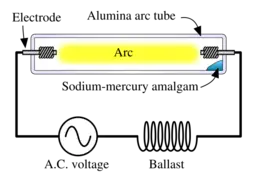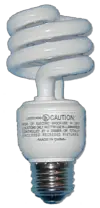Difference between revisions of "High-intensity discharge lamp" - New World Encyclopedia
(imported latest version of article from Wikipedia) |
|||
| Line 6: | Line 6: | ||
== Construction == | == Construction == | ||
| − | [[Image:High pressure sodium lamp.svg|thumb|255px|right|Diagram of a high pressure sodium lamp.]] | + | [[Image:High pressure sodium lamp.svg.png|thumb|255px|right|Diagram of a high-pressure sodium lamp.]] |
HID lamps produce light by striking an electrical arc across [[tungsten]] [[electrode]]s housed inside a specially designed inner [[fused quartz]] or fused [[alumina]] tube. This tube is filled with both [[gas]] and [[metal]]s. The gas aids in the starting of the lamps. Then, the metals produce the light once they are heated to a point of evaporation, forming a [[Plasma (physics)|plasma]]. | HID lamps produce light by striking an electrical arc across [[tungsten]] [[electrode]]s housed inside a specially designed inner [[fused quartz]] or fused [[alumina]] tube. This tube is filled with both [[gas]] and [[metal]]s. The gas aids in the starting of the lamps. Then, the metals produce the light once they are heated to a point of evaporation, forming a [[Plasma (physics)|plasma]]. | ||
| Line 40: | Line 40: | ||
==See also== | ==See also== | ||
| − | *[[ | + | |
| − | *[[ | + | * [[Fluorescent lamp]] |
| − | *[[ | + | * [[Incandescent lamp]] |
| + | * [[Light]] | ||
== References == | == References == | ||
| Line 69: | Line 70: | ||
{{ArtificialLightSources}} | {{ArtificialLightSources}} | ||
| − | [[Category: | + | [[Category:Physical sciences]] |
| + | [[Category:Electrical engineering]] | ||
| − | + | {{credits|High-intensity_discharge_lamp|114600283}} | |
| − | |||
| − | |||
Revision as of 15:51, 28 March 2007
High-intensity discharge (HID) lamps include these types of electrical lamps: mercury vapor, metal halide (also HQI), high-pressure sodium, low-pressure sodium and less common, xenon short-arc lamps. The light-producing element of these lamp types is a well-stabilized arc discharge contained within a refractory envelope (arc tube) with wall loading in excess of 3 W/cm² (19.4 W/in.²).
Compared with fluorescent and incandescent lamps, HID lamps produce a far higher quantity of light per unit area of lamp package.
Construction
HID lamps produce light by striking an electrical arc across tungsten electrodes housed inside a specially designed inner fused quartz or fused alumina tube. This tube is filled with both gas and metals. The gas aids in the starting of the lamps. Then, the metals produce the light once they are heated to a point of evaporation, forming a plasma.
Types of HID lamps include:
- Mercury vapor (CRI range 15-55)
- Metal halide (CRI range 65-80, ceramic MH can go to 90s)
- Low-pressure sodium (CRI 0 owing to their monochromatic light)
- High-pressure sodium (CRI range 22-75).
Mercury vapor lamps, which originally produced a bluish-green light, were the first commercially available HID lamps. Today, they are also available in a color corrected, whiter light. But they are still often being replaced by the newer, more efficient high-pressure sodium and metal halide lamps. Standard low-pressure sodium lamps have the highest efficiency of all HID lamps, but they produce a yellowish light. High-pressure sodium lamps that produce a whiter light are now available, but efficiency is somewhat sacrificed. Metal halide lamps are less efficient but produce an even whiter, more natural light. Colored metal halide lamps are also available.
Auxiliary devices
Like fluorescent lamps, HID lamps require a ballast to start and maintain their arcs. The method used to initially strike the arc varies: mercury vapor lamps and some metal halide lamps are usually started using a third electrode near one of the main electrodes while other lamp styles are usually started using pulses of high voltage.
Applications
HID lamps are typically used when high levels of light over large areas are required, and when energy efficiency and/or light intensity are desired. These areas include gymnasiums, large public areas, warehouses, movie theaters, outdoor activity areas, roadways, parking lots, and pathways. More recently, HID lamps, especially metal halide, have been used in small retail and residential environments. HID lamps have made indoor gardening practical, especially for plants that require a good deal of high intensity sunlight, like vegetables and flowers. They are also used to reproduce tropical intensity sunlight for indoor aquaria.
Some HID lamps such as Mercury Vapor Discharge produce large amounts of UV radiation and therefore need diffusers to block that radiation. In the last few years there have been several cases of faulty diffusers, causing people to suffer severe sunburn and Arc eye. Regulations may now require guarded lamps or lamps which will quickly burn out if their outer envelope is broken.
Recently, HID lamps have gained use in motor-vehicle headlamps. This application has met with mixed responses from motorists, mainly in response to the amount of glare that HID lights can cause. They often have an automatic self-leveling system to minimise this issue and as such are usually an expensive optional extra on most cars. However, many motorists still prefer these lights as they emit a clearer, brighter, more natural appearing light than normal headlamps.
HID lamps are used in high-end bicycle headlamps. They are desirable because they produce much more light than a halogen lamp of the same wattage. Halogen lights appear somewhat yellow in color; HID bicycle lights look faintly blue-violet.
HID lamps are also being used on many general aviation aircraft for landing and taxi lights.
End of life
At the end of life, many types of high-intensity discharge lamps exhibit a phenomenon known as cycling. These lamps can be started at a relatively low voltage but as they heat up during operation, the internal gas pressure within the arc tube rises and more and more voltage is required to maintain the arc discharge. As a lamp gets older, the maintaining voltage for the arc eventually rises to exceed the voltage provided by the electrical ballast. As the lamp heats to this point, the arc fails and the lamp goes out. Eventually, with the arc extinguished, the lamp cools down again, the gas pressure in the arc tube is reduced, and the ballast can once again cause the arc to strike. The effect of this is that the lamp glows for a while and then goes out, repeatedly.
More-sophisticated ballast designs detect cycling and give up attempting to start the lamp after a few cycles. If power is removed and reapplied, the ballast will make a new series of startup attempts.
See also
ReferencesISBN links support NWE through referral fees
- Waymouth, John (1971). Electric Discharge Lamps. Cambridge, MA: The M.I.T. Press. ISBN 0-262-23048-8.
- National Highway Traffic Safety Administration. Glare from headlamps and other front mounted lamps. Federal Motor Vehicle Safety Standard No. 108. US Department of Transportation. Retrieved 2006-01-23.
External links
| Sources of light / lighting: | ||
|---|---|---|
|
Natural/prehistoric light sources: |
Bioluminescence | Celestial objects | Lightning |
|
|
Combustion-based light sources: |
Acetylene/Carbide lamps | Candles | Davy lamps | Fire | Gas lighting | Kerosene lamps | Lanterns | Limelights | Oil lamps | Rushlights | |
|
Nuclear/direct chemical light sources: |
Betalights/Trasers | Chemoluminescence (Lightsticks) | |
|
Electric light sources: |
Arc lamps | Incandescent light bulbs | Fluorescent lamps | |
|
High-intensity discharge light sources: |
Ceramic Discharge Metal Halide lamps | HMI lamps | Mercury-vapor lamps | Metal halide lamps | Sodium vapor lamps | Xenon arc lamps | |
|
Other electric light sources: |
Electroluminescent (EL) lamps | Globar | Inductive lighting | Discrete LEDs/Solid State Lighting (LEDs) | Neon and argon lamps | Nernst lamp | Sulfur lamp | Xenon flash lamps | Yablochkov candles | |
Credits
New World Encyclopedia writers and editors rewrote and completed the Wikipedia article in accordance with New World Encyclopedia standards. This article abides by terms of the Creative Commons CC-by-sa 3.0 License (CC-by-sa), which may be used and disseminated with proper attribution. Credit is due under the terms of this license that can reference both the New World Encyclopedia contributors and the selfless volunteer contributors of the Wikimedia Foundation. To cite this article click here for a list of acceptable citing formats.The history of earlier contributions by wikipedians is accessible to researchers here:
The history of this article since it was imported to New World Encyclopedia:
Note: Some restrictions may apply to use of individual images which are separately licensed.


